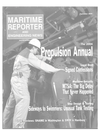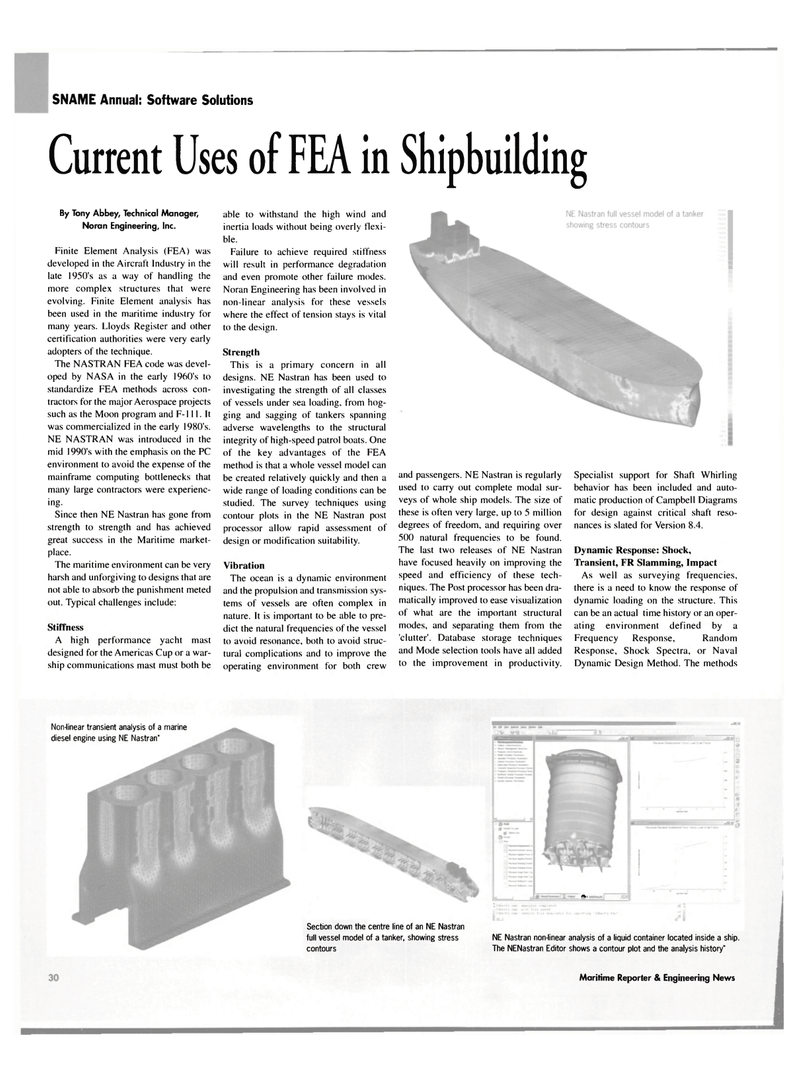
Page 31: of Maritime Reporter Magazine (September 2004)
Marine Propulsion Annual
Read this page in Pdf, Flash or Html5 edition of September 2004 Maritime Reporter Magazine
SNAME Annual: Software Solutions
Current Uses of FEA in Shipbuilding
By Tony Abbey, Technical Manager,
Noran Engineering, Inc.
Finite Element Analysis (FEA) was developed in the Aircraft Industry in the late 1950's as a way of handling the more complex structures that were evolving. Finite Element analysis has been used in the maritime industry for many years. Lloyds Register and other certification authorities were very early adopters of the technique.
The NASTRAN FEA code was devel- oped by NASA in the early 1960's to standardize FEA methods across con- tractors for the major Aerospace projects such as the Moon program and F-111. It was commercialized in the early 1980's.
NE NASTRAN was introduced in the mid 1990's with the emphasis on the PC environment to avoid the expense of the mainframe computing bottlenecks that many large contractors were experienc- ing.
Since then NE Nastran has gone from strength to strength and has achieved great success in the Maritime market- place.
The maritime environment can be very harsh and unforgiving to designs that are not able to absorb the punishment meted out. Typical challenges include:
Stiffness
A high performance yacht mast designed for the Americas Cup or a war- ship communications mast must both be able to withstand the high wind and inertia loads without being overly flexi- ble.
Failure to achieve required stiffness will result in performance degradation and even promote other failure modes.
Noran Engineering has been involved in non-linear analysis for these vessels where the effect of tension stays is vital to the design.
Strength
This is a primary concern in all designs. NE Nastran has been used to investigating the strength of all classes of vessels under sea loading, from hog- ging and sagging of tankers spanning adverse wavelengths to the structural integrity of high-speed patrol boats. One of the key advantages of the FEA method is that a whole vessel model can be created relatively quickly and then a wide range of loading conditions can be studied. The survey techniques using contour plots in the NE Nastran post processor allow rapid assessment of design or modification suitability.
Vibration
The ocean is a dynamic environment and the propulsion and transmission sys- tems of vessels are often complex in nature. It is important to be able to pre- dict the natural frequencies of the vessel to avoid resonance, both to avoid struc- tural complications and to improve the operating environment for both crew and passengers. NE Nastran is regularly used to carry out complete modal sur- veys of whole ship models. The size of these is often very large, up to 5 million degrees of freedom, and requiring over 500 natural frequencies to be found.
The last two releases of NE Nastran have focused heavily on improving the speed and efficiency of these tech- niques. The Post processor has been dra- matically improved to ease visualization of what are the important structural modes, and separating them from the 'clutter'. Database storage techniques and Mode selection tools have all added to the improvement in productivity.
Specialist support for Shaft Whirling behavior has been included and auto- matic production of Campbell Diagrams for design against critical shaft reso- nances is slated for Version 8.4.
Dynamic Response: Shock,
Transient, FR Slamming, Impact
As well as surveying frequencies, there is a need to know the response of dynamic loading on the structure. This can be an actual time history or an oper- ating environment defined by a
Frequency Response, Random
Response, Shock Spectra, or Naval
Dynamic Design Method. The methods
Non-linear transient analysis of a marine diesel engine using NE Nastran"
Section down the centre line of an NE Nastran full vessel model of a tanker, showing stress contours
NE Nastran non-linear analysis of a liquid container located inside a ship.
The NENastran Editor shows a contour plot and the analysis history"
Maritime Reporter & Engineering News
Si

 30
30

 32
32
